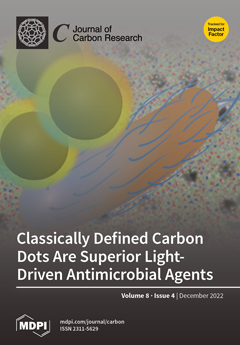Here, graphitic carbon nitride (g-C
3N
4) was synthesized from melamine, doped with heteroatoms, such as B, S, and P reported using boric acid, sulfur, and phosphorous red as dopants, respectively. The catalytic performances of g-C
3N
4, and
[...] Read more.
Here, graphitic carbon nitride (g-C
3N
4) was synthesized from melamine, doped with heteroatoms, such as B, S, and P reported using boric acid, sulfur, and phosphorous red as dopants, respectively. The catalytic performances of g-C
3N
4, and heteroatom-doped g-C
3N
4 (H@g-C
3N
4 (H=B, S or P) particles as catalysts in the dehydrogenation of sodium borohydride (NaBH
4) in methanol to generate hydrogen (H
2) were investigated. The prepared g-C
3N
4-based structures were used as catalysts for hydrogen (H
2) production in the dehydrogenation reaction of sodium borohydride (NaBH
4) in methanol. The catalytic performance of H@g-C
3N
4 (H=B, S or P) structures in the dehydrogenation reaction of sodium borohydride (NaBH
4) in methanol was determined to be higher than the catalytic performance of the bare g-C
3N
4 structure. The hydrogen generation rate (HGR) values were calculated for the reactions catalyzed by B@g-C
3N
4, P@g-C
3N
4, and S@g-C
3N
4 as 609 ± 48, 699 ± 48, and 429 ± 55 mL H
2/g of cat.min, respectively, which is only 282 ± 11 mL H
2/g of cat.min for the native g-C
3N
4-catalyzed one. The activation energies (Ea) were found to be relatively low, such as 31.2, 26.9, and 31.2 kJ/mol, for the reactions catalyzed by B@g-C
3N
4, P@g-C
3N
4, and S@g-C
3N
4, respectively. In addition, in the reuse studies, it was concluded that B@g-C
3N
4, P@g-C
3N
4, and S@g-C
3N
4 catalysts can readily complete the reaction with 100% conversion, even in five consecutive uses, and afforded promising potential with more than 80% activity for each use.
Full article





